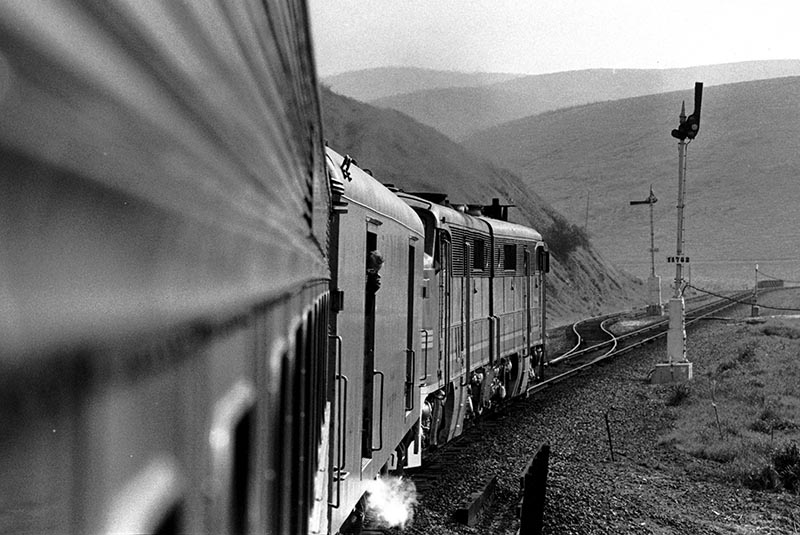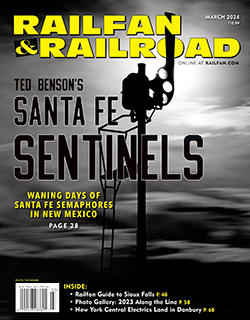 by Ted Benson/photos by the author
by Ted Benson/photos by the author
The First Time
I knew they were old the first time I saw them. Signals synonymous with a century of steam, the Southern Pacific semaphores in Oakland, Calif., were ancient technology by 1958. Back home in Modesto, state-of-the-art searchlights had protected SP operations for as long as I could remember — as if it mattered. Trains were my primary focus in those pre-teen years. Automatic block signals, no matter how old, were just part of the scene.
Raised in a community founded by Central Pacific, my railroad world revolved around the Espee. Santa Fe steel lay five miles from our home, but it might as well have been 500 given the omnipresent Octopus. I was a 20-year-old junior at San Jose State College in 1968 before AT&SF really registered in my expanding railfan consciousness.
Photography on the west end of Santa Fe’s Valley Division demanded dedication. Rail traffic east of Richmond was sparse prior to the advent of short, fast freights in the early 1970s. Five trains in 12 hours was a busy day for Franklin Canyon. Two miles away in Martinez, SP could match that number in 90 minutes. Given the lack of action, it was easy to shortchange AT&SF.
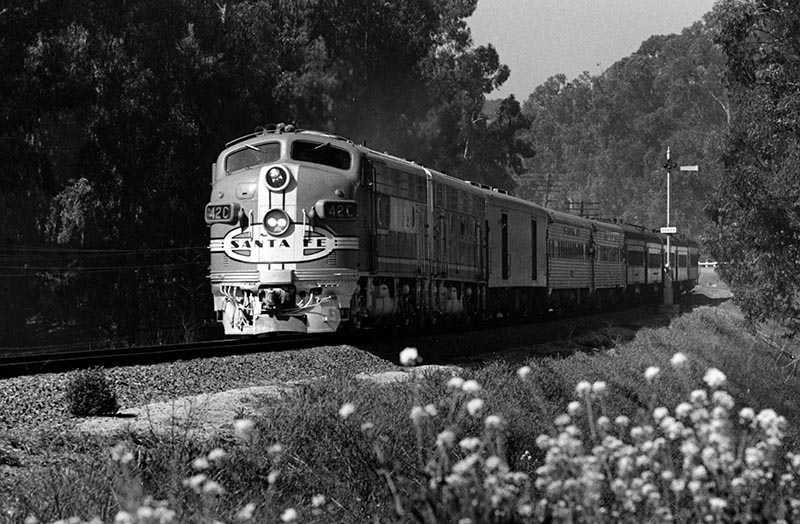
ABOVE: One year after the Alco excursion, F7s are in charge of another fan trip as Extra 42C East rolls past Signal 11801 between Pinole and Herpoco en route to Riverbank, Calif., on Sunday, March 23, 1969. Wild mustard and fragrant eucalyptus trees frame the bucolic scene.
Doing so was a decision I’d come to regret, for Santa Fe was an uncommon carrier of deep-rooted tradition. Passengers rode behind sleek, streamlined cab units in red, silver, and yellow paint unchanged since 1937. Gold leaf decorated every depot. Cabooses displayed proper kerosene markers. And then there were the semaphores.
Santa Fe began installing automatic block signals on the Valley Division in 1917. By 1925, Union Switch & Signal Style S semaphores protected 223 of the 304 miles between Bakersfield and Ferry Point in Richmond. Forty years later, a significant number of original signals remained on the final 30 miles west of Pittsburg. While trains into Richmond may have been few in the late sixties, semaphores in scenic surroundings made each one worth the wait.
Constant
Half a century of railroad photography has taught me one simple truth — the only constant is change. It’s the fascination with an industry in flux that keeps us coming trackside. The attraction can be defined in four words — “rolling stock” and “fixed plant.” “Rolling stock” reflects the ever-evolving technology of trains in motion. “Fixed plant” is railroading’s bedrock, rights-of-way forever in place. Bridges, structures, and signals form a foundation that never changes — until it does.
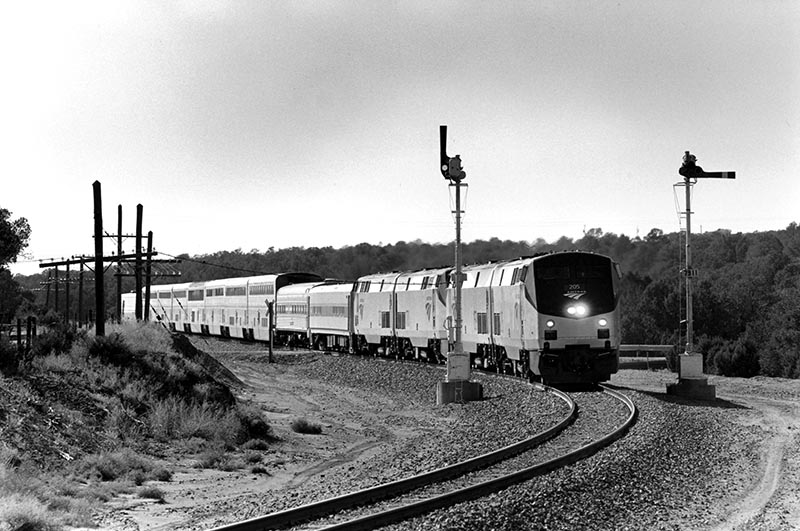
ABOVE: With a consist swollen by equipment returning from PTC testing on state-owned track south of Albuquerque, Amtrak Train 4 parts the blades at Bernal on Thursday, October 8, 2020. Amtrak units 205, 159, 170, and 22 lead test cars 5351 and 10250 ahead of seven Superliners and a baggage car.
I never intended to become a “signal geek.” The thought of signals as primary subject matter didn’t cross my mind until good friend Dick Dorn and I spent four spectacular days chasing SP 4449 on Oregon’s Siskiyou Line in December 1988. The combination of steam, sun, and semaphores was beyond compare.
Dorn’s steadfast devotion to the stalwart Style Bs removed any doubt I had about photographers whose work favored signals over the trains they framed. Given the negative influence of Positive Train Control, it was no surprise to find myself focusing on legacy signal installations after 2008. The searchlights I’d once taken for granted had witnessed the final years of steam before guiding three generations of diesel power. Touchstones to companies long folded into the pages of history, the iconic H2s became beacons into the past — worthy subjects with or without passing trains.
Semaphores? They were downright prehistoric. By 2018, most of the nation’s remaining blades had disappeared —with one notable exception. Ten years after the PTC hammer dropped on a century of railroad tradition, more than three dozen Santa Fe semaphores still served in a far corner of New Mexico. It was time to saddle up for Raton.
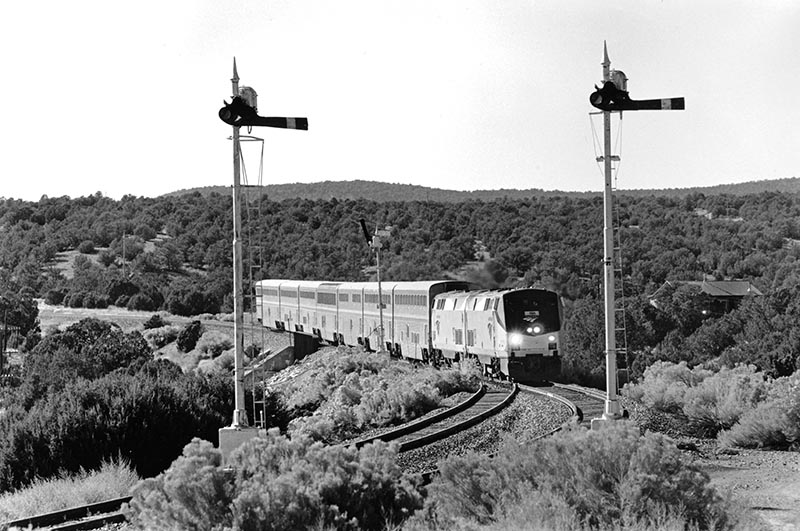
ABOVE: Framed by the semaphores at the west end of Chapelle siding, Amtrak Train 4 glides across Bernal Creek following a 1.55 percent descent from Blanchard on October 10, 2020. Heavy trackside vegetation lends a branch line feel not completely out of character for a railroad hosting just two trains a day.
High Green
A series of fortunate events dating to the early 1900s ensured the survival of Santa Fe’s final semaphores into the 21st century. A quarter century after the railway opened to Albuquerque, N.M., in 1880, most of AT&SF’s transcontinental freight moved south to the new Belen Cutoff via Clovis. After 1908, Santa Fe passenger traffic would dominate the mountain crossings at Glorieta and Raton.
Faster, more frequent schedules brought automatic block signals to the New Mexico Division in 1921, beginning with 33 miles of semaphores west of Las Vegas. The US&S Style T-2s were a significant improvement over the base-of-mast chain-driven Style S semaphores employed on Santa Fe’s Coast Lines.
The next 80 years saw tonnage operations west of Raton steadily winding down, accelerating on the heels of the Burlington Northern Santa Fe merger in 1995, finishing in 2007 following a partial line sale to the state of New Mexico for commuter rail service. Freight’s demise was the saving grace for Santa Fe’s silent sentinels. Signal replacements that had been chipping away at the remaining T-2s came to a virtual halt as BNSF downplayed capital improvements on the Amtrak route. With the Southwest Chiefs scheduled to meet outside ABS territory, Positive Train Control was a moot point.
Summer 2018 found 47 semaphores in service between Albuquerque and La Junta, Colo. Five were single overlap signals in isolated locations on state-owned track west of Lamy, N.M. The other 42 were clustered in two segments east and west of Las Vegas. Working out of Raton, it was possible to spend a full day photographing Amtrak trains 3 and 4 as far as Lamy with two semaphore shots in each direction. Two trains daily didn’t seem like much at first, but given track speeds up to 79 mph and some long miles between photo locations, they were more than enough.
Talking to a signal maintainer on our first trip, Dave Styffe and I noted how the weathered blade of Signal 7881 at the east end of Chapelle blended into a distant mesa when in the stop position. Returning the following day, we were astounded to find the back of the blade wearing a fresh coat of black!
One year later, every semaphore blade west of Las Vegas sported fresh coats of black along with a single aluminum stripe. September 19, 2019, saw Train 3 approaching the east switch at Chapelle protected by three 98-year-old semaphores bearing witness to time-honored Santa Fe pride…


